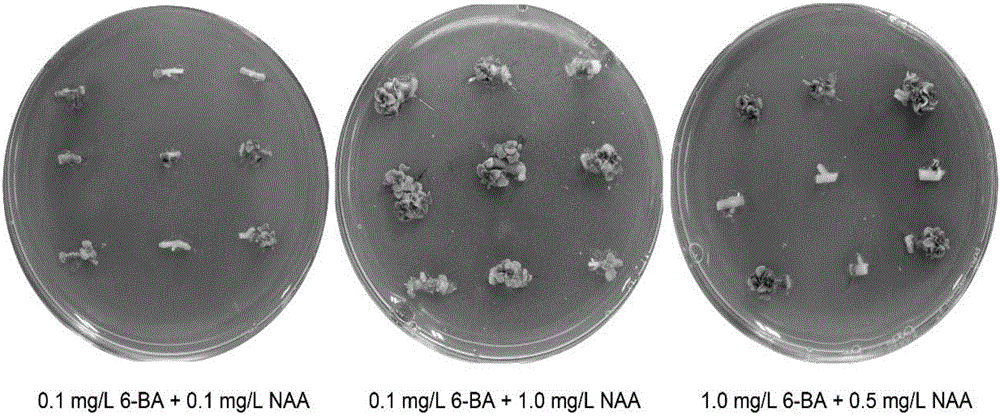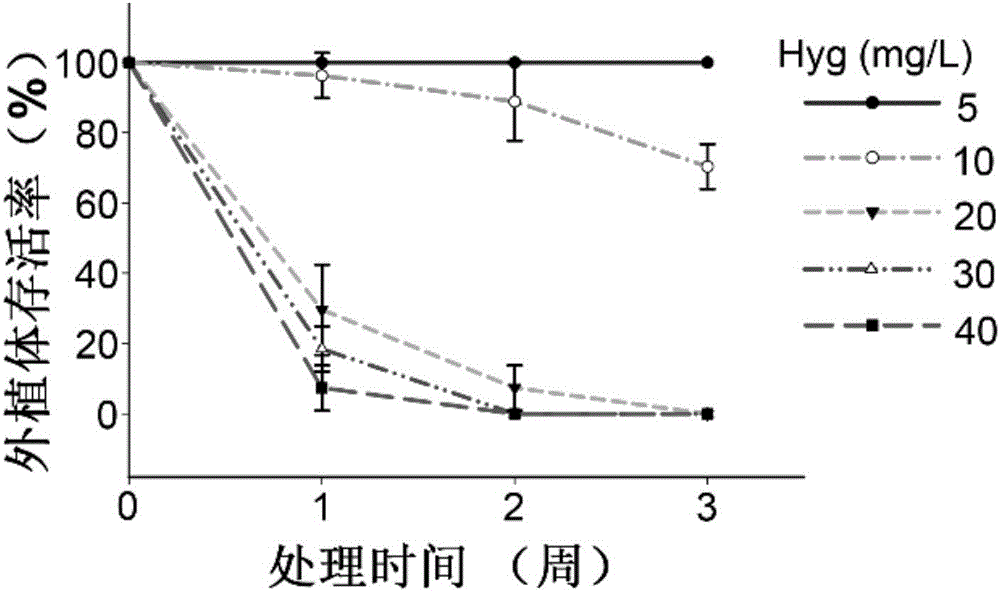Genetic transformation method for sedum plant
A genetic transformation method, the technology of Sedum genus, applied in biochemical equipment and methods, using vectors to introduce foreign genetic material, recombinant DNA technology, etc., can solve the problems of not having hyperaccumulation and high resistance, and achieve major applications Promote the effect of high value and high genetic transformation rate
- Summary
- Abstract
- Description
- Claims
- Application Information
AI Technical Summary
Problems solved by technology
Method used
Image
Examples
Embodiment 1
[0068] Embodiment 1, the optimization of clustering bud induction parameter
[0069] Use the stem segment of Sedum sedum as explants to induce clustered buds, and the specific steps are as follows:
[0070] 1. To collect fresh stems of Sedum sedum, follow the steps below:
[0071] Rinse with tap water→disinfect with 75% (volume ratio) alcohol aqueous solution for 30s→rinse with sterile water for 3 times and blot dry with sterile filter paper→use 0.1g / 100mL HgCl 2 Soak in aqueous solution for 6 minutes (shake gently during the period) → rinse with sterile water at least 4 times and blot dry with sterile filter paper.
[0072] 2. After step 1 is completed, the stem is longitudinally cut into stem sections with a length of about 1 cm (each stem section has 1 stem node).
[0073] 3. Get the stem section obtained in step 2, place it on the bud induction medium and cultivate it for 3 weeks (subculture once a week, all adopt the same bud induction medium; culture conditions: 25°C, ...
Embodiment 2
[0079] Embodiment 2, optimization of screening parameters
[0080] 1. Same as step 1 in Example 1.
[0081] 2. Same as step 2 of embodiment 1.
[0082] 3. Take the stem segment obtained in step 2 and place it on the bud induction medium for 3 weeks (subculture once a week, all using the bud induction medium; culture conditions: 25° C., 14 hours of light / 10 hours of darkness).
[0083] The bud induction medium is MS solid medium (pH5.8) containing 0.1 mg / L 6-BA and 1.0 mg / L NAA.
[0084] 4. After completing step 3, take the stem segment with clustered buds, cut off the leaves and place it on the screening medium for 3 weeks (subculture once a week, all using the same screening medium; culture conditions: 25 ° C, 14 hours of light / 10 hours of darkness).
[0085] The screening medium was MS solid medium (pH5.8) containing antibiotics, 0.1 mg / L 6-BA and 1.0 mg / L NAA. When the antibiotic is hygromycin (Hyg), the concentration in the selection medium is 5 mg / L, 10 mg / L, 20 mg / L...
Embodiment 3
[0089] Embodiment 3, genetic transformation
[0090] The plant expression vector used is pSN1301 plasmid. The pSN1301 plasmid is transformed on the basis of the pCAMBIA1301 plasmid, and has a GUS reporter gene driven by the CaMV 35S promoter. The literature that records the pSN1301 plasmid is: Guo, J.; Dai, X.; Xu, W.; Ma, M. Overexpressing GSH1 and AsPCS1 simultaneously increases the tolerance and accumulation of cadmium and arsenic in Arabidopsis thaliana. Chemosphere 2008, 72, 1020-1026 .). The schematic diagram of the elements of the pSN1301 plasmid is shown in Figure 4 . Figure 4 Middle: LB represents T-DNA insertion left border; RB represents T-DNA insertion right border; HPT represents hygromycin phosphotransferase gene; 35SP represents CaMV35 promoter; MCS represents multiple cloning site; GUS represents β-glucoside acidase gene.
[0091] 1. Preparation of infection solution
[0092] 1. Introduce the pSN1301 plasmid into Agrobacterium tumefaciens C58 to obtain ...
PUM
| Property | Measurement | Unit |
|---|---|---|
| length | aaaaa | aaaaa |
Abstract
Description
Claims
Application Information
 Login to View More
Login to View More - R&D
- Intellectual Property
- Life Sciences
- Materials
- Tech Scout
- Unparalleled Data Quality
- Higher Quality Content
- 60% Fewer Hallucinations
Browse by: Latest US Patents, China's latest patents, Technical Efficacy Thesaurus, Application Domain, Technology Topic, Popular Technical Reports.
© 2025 PatSnap. All rights reserved.Legal|Privacy policy|Modern Slavery Act Transparency Statement|Sitemap|About US| Contact US: help@patsnap.com



